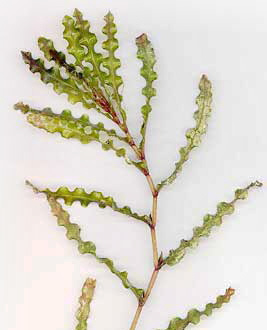Invasive - Eradicate!
Curly Leaf Pondweed, also known as Curly cabbage or crisp pondweed, is a non-native aquatic invasive species introduced from Europe. Curly-leaf is believed to spread primarily by the transfer of turions, and on plant fragments carried on trailered boats, personal watercraft, wildlife, etc.

Problems
In spring, curly-leaf pondweed can form dense mats that may interfere with boating and other recreation on lakes. Curly-leaf also can cause ecological problems because it can displace native aquatic plants.
In midsummer, curly-leaf plants usually die back, which results in rafts of dying plants piling up on shorelines, and often are followed by an increase in phosphorus, a nutrient, and undesirable algal blooms.
Like other aquatic vegetation, the abundance of curly-leaf varies from year to year depending on environmental conditions, such as winter snow depth, and spring water clarity, which can affect its growth.
Plant Description:
Curly-leaf pondweed leaves are somewhat stiff and crinkled, resembling lasagna noodles. They are approximately 1/2 inch wide and 2 - 3 inches long. The leaves are arranged alternately around the stem. Leaves become denser at the end of branches.
Hints to Identify:
Curly Leaf has small "teeth" visible along edge of leaf. It begins growing in early spring before most other pondweeds and dies back during midsummer.

The flower stalks, when present, stick up above the water surface in June; appears reddish-brown in the water, but is actually green when pulled out of the water and examined closely. Easily confused with clasping leaf pondweed, which has leaves with no "teeth" around their edges.
Common Application Questions
Q. When is the best time to treat?
A. You can get after this plant early! Once water temperatures are around fifty-five degrees or warmer and the plant is viable.
Q. How often do I need to treat Curly-leaf Pondweed?
A. Only once - it will not grow back the same season.
Q. How long before I see results?
A. Generally within seven to ten days things will be cleared up.
| Homeowner Treatment Options |
| Aquathol K |
| Aquathol Super K |
| Hydrothol® Granular |
| Sonar AS |
| Sonar RTU |
| *Aquatic Biologists recommends implementing preventative management techniques and physical removal prior to, or in conjunction with treatment. |
